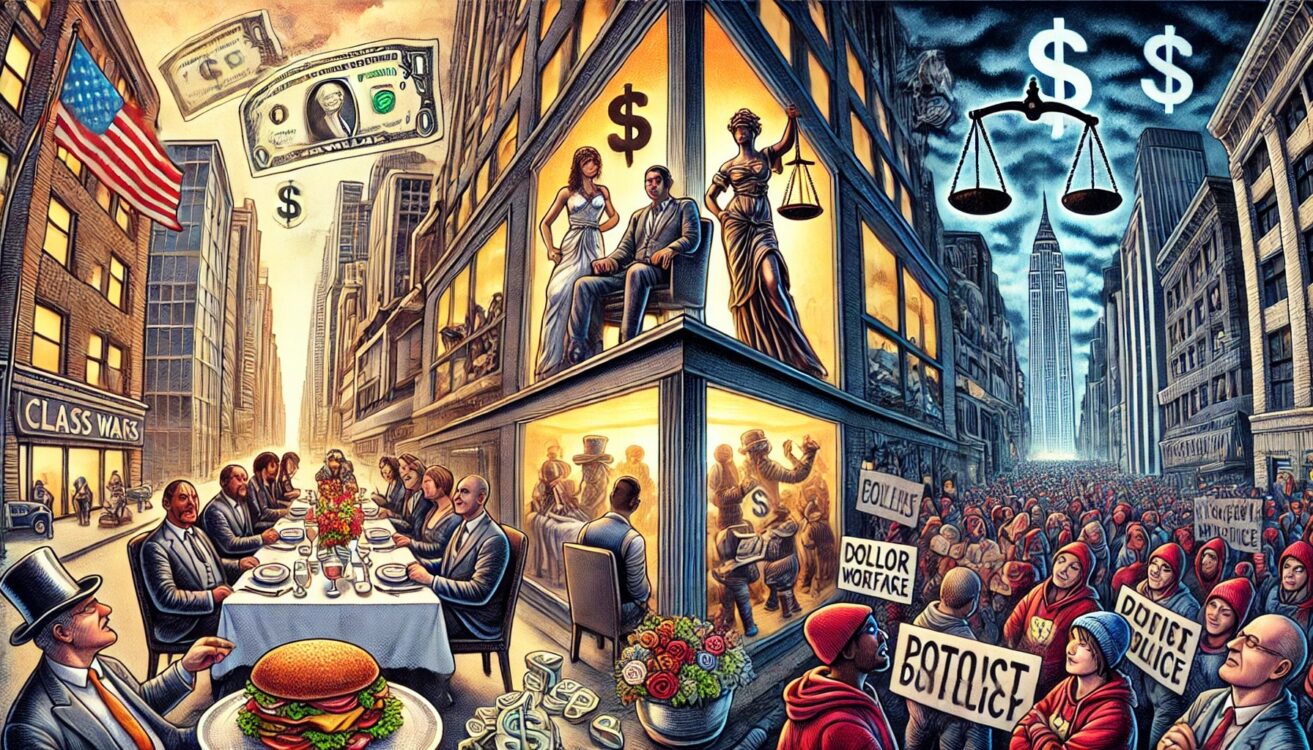
By Michael J. Tyler
In contemporary America, the concept of “class warfare” has emerged as a significant theme in both political discourse and social commentary, revealing deep-seated economic and social divides. This term, often used to describe the tension between different economic classes, has historical roots that trace back to the industrial age but resonates strikingly with current socio-economic conditions.
Historical Context
The idea of class warfare in America isn’t new. Since the nation’s founding, there has been a tension between the interests of the wealthy elite and those of the working class, though the term itself gained prominence through Marxist theories of class struggle. However, in the American context, class warfare has more often been about policy debates, particularly concerning taxation, income disparity, and access to opportunities, rather than the revolutionary overthrow of one class by another.
- Post-War Era: After World War II, the U.S. experienced significant economic growth, which temporarily moderated class tensions through widespread prosperity. However, by the late 20th century, debates around tax policies, welfare, and labor rights began to rekindle class warfare rhetoric.
- 1980s Onwards: The Reagan era marked a shift towards policies that favored deregulation, tax cuts for the wealthy, and a reduction in social welfare programs, which many saw as exacerbating income inequality. This period saw the term “class warfare” used by both sides: conservatives to decry what they saw as punitive taxation on the rich, and liberals to criticise policy benefits for the affluent at the expense of the middle and working classes.
Current Discussions and Manifestations
- Economic Inequality: Today’s discussions around class warfare are heavily influenced by stark economic disparities. Reports from the Federal Reserve highlight that the top 1% have more wealth than the bottom 60%, fueling debates on wealth distribution, tax policy, and the social safety net.
- Political Rhetoric: Politicians from both ends of the spectrum engage with class warfare themes. Liberals often push for policies aimed at reducing inequality, like progressive taxation or wealth taxes, while some conservatives argue these policies are a form of class warfare against the successful. This was particularly evident during debates on the Affordable Care Act and subsequent healthcare reforms.
- Cultural and Social Dimensions: Beyond economics, class warfare in America also manifests in cultural and social battles, where issues of race, education, and access to opportunities are seen through the lens of class. The Occupy Wall Street movement of 2011, for instance, highlighted the “99% vs. 1%” narrative, emphasising economic inequality but also touching on broader cultural divides.
- Public Sentiment: Recent sentiments on platforms like X show a growing frustration among some segments of the population, viewing economic policies and corporate practices as inherently classist, fostering a narrative of an ongoing “war” between the working class and the ruling elite. Comments on these platforms often reflect a belief in an entrenched class system where the rich manipulate economic and political systems to their advantage.
Implications for Society
- Policy and Legislation: The discourse around class warfare influences policy-making, often leading to contentious debates over tax reforms, minimum wage laws, labor rights, and healthcare. These debates are not just about economics but about the vision of what kind of society America should be.
- Social Cohesion: The narrative of class warfare can both mobilise and polarise society. On one hand, it can galvanise movements for social justice; on the other, it can deepen social divides, leading to a lack of trust in institutions and among different social groups.
- Future Directions: As technology reshapes the job market, wealth continues to concentrate, and political polarisation grows, class warfare rhetoric might intensify. Whether this leads to meaningful policy reform or further societal fragmentation remains to be seen.
In essence, class warfare in America is less about physical conflict and more about a continuous debate on how wealth and power should be distributed, the role of government in ensuring equity, and the cultural ramifications of economic disparity. The term serves as a shorthand for complex socio-economic issues that need nuanced discussion and action to address underlying inequities.
Illustration reflecting the theme of “Class Warfare in America: An Ongoing Narrative,” depicting the stark contrasts and tensions between socio-economic groups.